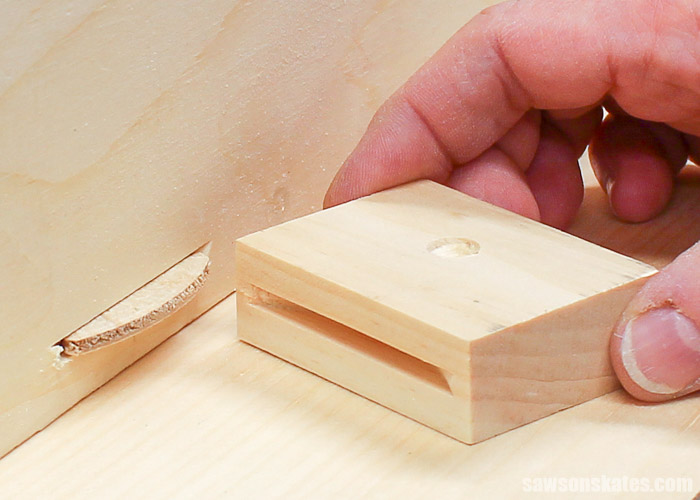 table top fasteners will help to prevent cracking caused by movement from seasonal changes." width="700" height="500" />
table top fasteners will help to prevent cracking caused by movement from seasonal changes." width="700" height="500" />Wood table tops can crack if they’re attached the wrong way. Learn how to attach a table top the right way to a base with table top fasteners.
 table top fasteners will help to prevent cracking caused by movement from seasonal changes." width="700" height="500" />
table top fasteners will help to prevent cracking caused by movement from seasonal changes." width="700" height="500" />
Table top fasteners are an easy way to attach a top to a table. But there’s another reason to use figure 8 fasteners, kerf fasteners, expansion brackets, or DIY table top fasteners. They allow for movement caused by seasonal changes.
A wood table top attached without allowing for movement can cause the wood to crack or split over time. Table top fasteners will enable the top to move throughout the seasons. Allowing the top to move will help prevent cracking and ensure your DIY table top will be beautiful for years to come.
Related: DIY Farmhouse Table Top Plans (with Breadboard Ends)
This tutorial contains affiliate links to supplies and tools. Purchases made using these links help support the Saws on Skates website and allows me to share more projects and tips with you. There is no cost to you for using these links. Visit my site policies for more information.
It’s important to have an understanding of wood when building DIY furniture projects. Not just how to cut and assemble with wood but also to understand how it works. In Mistakes with Wood Can Cause Your DIY Furniture to Crack, we talked about how wood is hygroscopic. Simply put, hygroscopic means it absorbs moisture from the air. Seasonal changes cause wood to absorb and release moisture.
This continuous absorption and release of moisture causes the wood to swell and shrink. This swelling and shrinking causes the wood to move, and this movement causes issues. When it’s more humid, the moisture in the air is absorbed, and the wood swells. The swelling actually has enough force to push and pull joints apart. Worse yet, if the wood is joined incorrectly, it can cause the wood to crack and split.
One of the most common projects to crack is a wood table top. Many times when building a table, the top is attached without taking wood movement into consideration. Recently I received a message from June, who wanted to learn more about the correct way to attach a table top:
Thank you so much for this great article! I would love if you could explain more in depth how to attach table tops and add illustrations – I had a hard time visualizing what you meant in your post about your apothecary cabinet and the screws/washers. I don’t have a router or biscuit joiner. Is it a lost cause until I have one of those?”
Thank you so much for reaching out and for the questions. I love hearing from you guys! And yes, absolutely, let’s look more closely at ways to attach a wood table top properly.
Before we look at the correct way to attach a wood table top, let’s look at the incorrect way to attach a table top. I’ve been guilty of incorrectly attaching a table top when building a table or even a stool.
First, let me say I LOVE pocket hole joinery! There’s an entire resource center dedicated to Kreg Jig Tips and Tricks, and there’s even a page where you can ask your pocket hole questions. But pocket hole joinery is not the best solution to attach a table top.
Using pocket holes to attach a top to a base prevents the top from moving during seasonal changes. It’s also not a good idea to drive screws through the edge of the apron into the table top. Over time the top could crack, or the top could have enough force to push or pull the joints of the base apart.
A better option for attaching a table top when building a table is to use store-bought table top fasteners or DIY table top fasteners. Table top fasteners securely attach a table top to a base but allows the top to move freely during seasonal changes.
One of the easiest options for attaching a table top to a furniture project is a figure 8 fastener. A Forstner bit is used to drill holes in the apron, and the figure 8 fastener is screwed to the apron. The top is then placed on the DIY table, and the top is attached with screws through the figure 8 fastener.
Need help installing figure 8 fasteners? My friend Vineta at The Handyman’s Daughter has you covered! Check out her step by step tutorial that explains exactly how to install a table top using these fasteners.
Photo credit: Amazon
Another option for attaching a table top to a furniture project is a “Z” fastener or kerf fastener. With this option, a groove is cut in the apron using the kerf or width of a table saw blade. Then the table top fastener is inserted into the groove and attached to the table top with a screw.

Photo credit: Amazon
Expansion brackets are even simpler to install than figure 8 fasteners or kerf fasteners because you don’t need to drill a hole or cut a slot.
All you have to do is position the top on the base. Then use screws to attach the expansion bracket to the top and aprons.
I used expansion brackets to attach the top to the base of this nightstand.
Photo credit: Amazon
Using scrap wood and a plate joiner or biscuit joiner, you can make your own DIY table top fasteners. For this example, I used “0” biscuits. “0” biscuits are about 2” long.
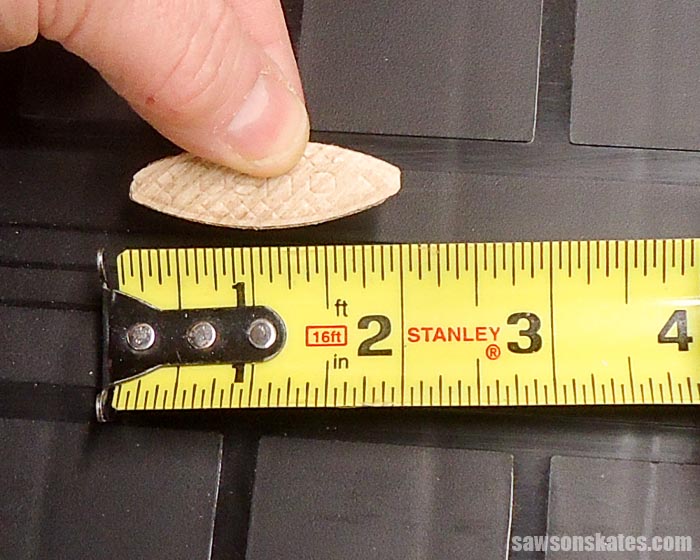 table top fastener to move when attached to the wood table top" width="700" height="560" />
table top fastener to move when attached to the wood table top" width="700" height="560" />
The DIY fasteners need to be wider than the biscuit, so I made marks every 2-½” on a scrap piece of 1×2. Then drew lines using a Kreg Multi-Mark to make sections.
I placed the board on the Kreg Mobile Project Center and against the bench dogs. I used the biscuit joiner to cut slots in the middle of each section.
Using a miter saw, I cut the sections apart. It’s not critical that the DIY fasteners are the same width, so just use the lines you drew as a guide for cutting.
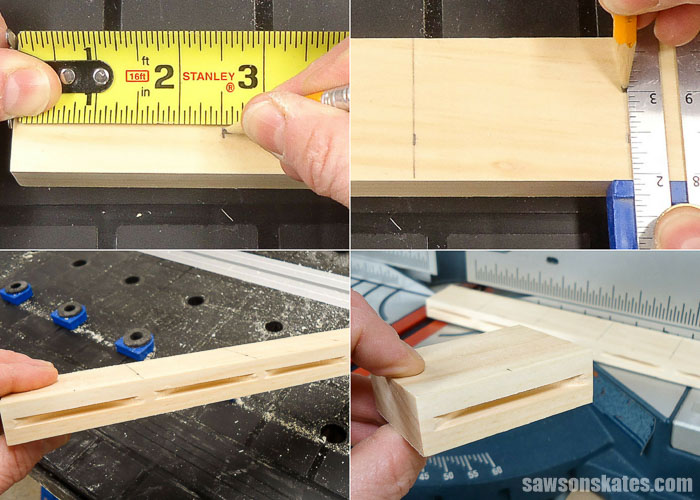 table top fasteners" width="700" height="500" />
table top fasteners" width="700" height="500" />
Use a countersink bit to drill a hole in each DIY fastener. Make sure not to drill through the biscuit slot.
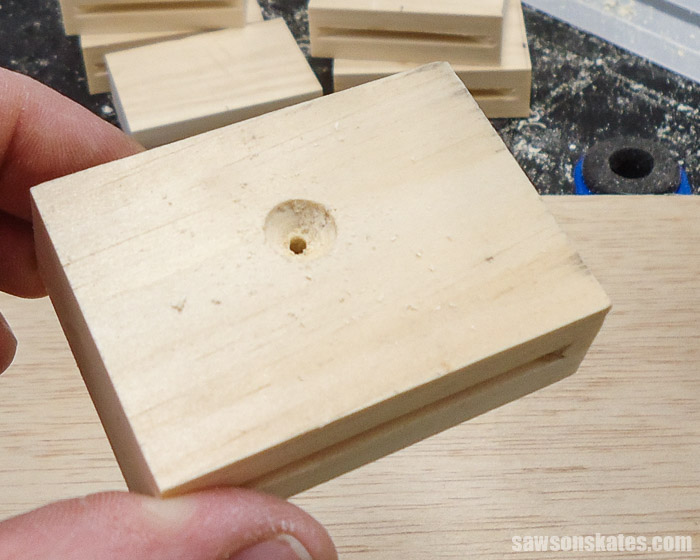 table top fastener will attach to the wood table top it to the " width="700" height="560" />
table top fastener will attach to the wood table top it to the " width="700" height="560" />
Next, cut biscuit slots around the inside edge of the apron.
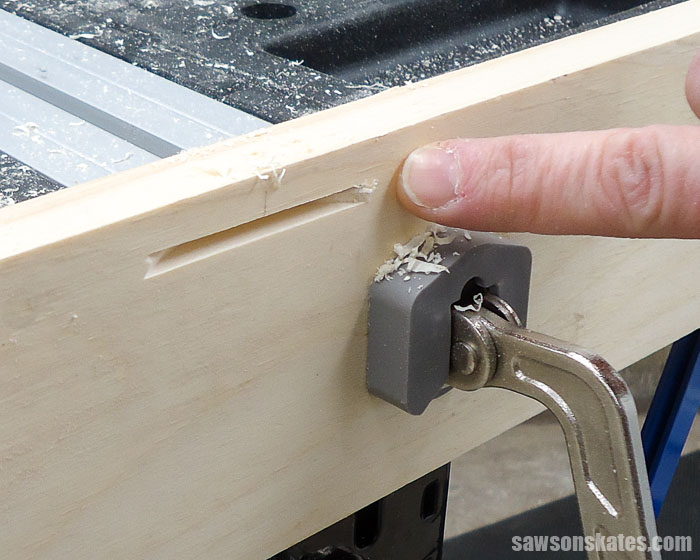 table top fastener to move freely when attached to the wood table top" width="700" height="560" />
table top fastener to move freely when attached to the wood table top" width="700" height="560" />
Place the apron on the table top, insert a biscuit and slide the DIY fastener over the biscuit. Do not apply glue to the biscuit. The biscuit is what allows the table top to move during seasonal changes. Attach the fastener with a wood screw.
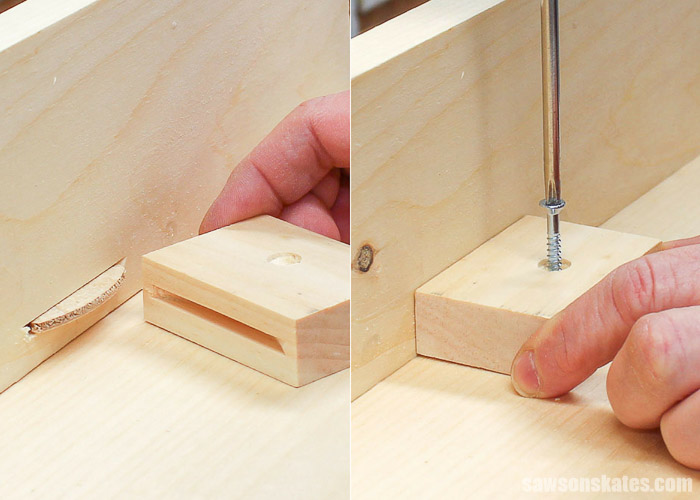 table top fastener to the wood table top" width="700" height="500" />
table top fastener to the wood table top" width="700" height="500" />
If it isn’t feasible to attach your table top to the base by the aprons, you can do what I did for the wine cabinet and apothecary cabinet. I drilled oversized holes in the top braces.
Then attached the table top to the base with washers and screws. The oversized holes allow the top to move freely, and the washers keep the screws from falling into the holes.